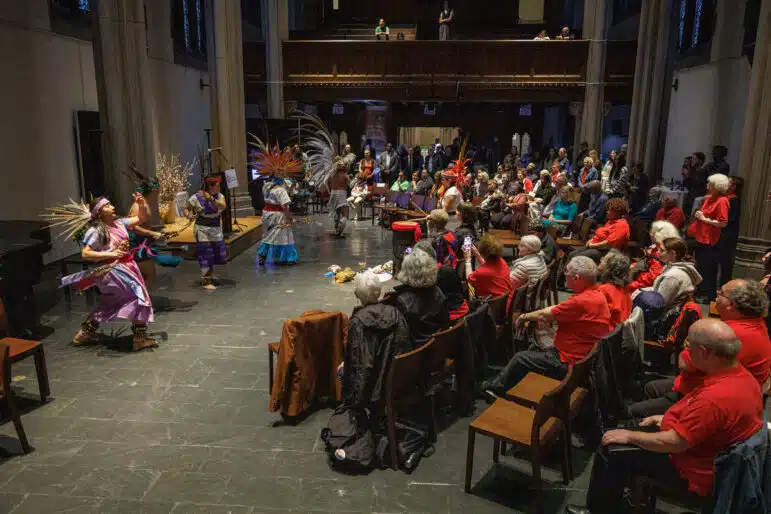
Return to Source: Honoring 10 Years of Center for Earth Ethics
“Tonight, we celebrate the Earth and the vision and the energy that the first Earth Day brought. Here tonight, we lift up what is good and beautiful and true about the life force we share. And we bring a different vision. We return to source.”
Karenna Gore’s reflection captured the spirit of the Center for Earth Ethics’ Earth Day celebration on Tuesday, April 22. “Return to Source” brought together artists, scientists, Indigenous leaders, activists and community members to Union Theological Seminary to honor the Earth and celebrate the Center’s ten-year anniversary.
Founded on Earth Day in 2015 in the wake of the Religions for the Earth conference, CEE convenes voices from faith, science, culture and activism to address the moral, spiritual and ethical dimensions of the climate crisis. The anniversary celebration was both a retrospective and a re-dedication—a space of joy, reverence and resolve.
Union Theological Seminary President Serene Jones spoke of the Center’s growth and its significance to the Union community. She praised CEE as “a moral voice” in the climate movement and affirmed its role in “bringing faith to bear on the most pressing issues of our time.”
The day began in the seminary courtyard with a ceremonial gathering led by CEE Senior Fellow Veronica Raya and UTS PhD candidate and Buddhist nun Xian’an. Attendees co-created an Earth altar, placing offerings of flowers, fruits, stones and other symbols of life’s interconnection.
As the program moved into James Chapel, it unfolded as a tapestry of prayer, reflection, ceremony and artistic offerings from honored guests. Lyla June Johnston, a poet, musician, scholar and longtime CEE friend who acknowledges her Diné, Tsétsêhéstâhese and European lineages, invoked spiritual resistance and joy.
“I want us to remember that our ancestors around the world have faced oppression before. And in those moments, the thing that brought them out of it was devotion and prayer to the Creator,” she said. “No matter what you call that Creator, there is a force that is loving—and that force is here with us today too.”
So many people have brought their own past, ideas, visions and callings into this space. And we have grown from that in ways that would be impossible to fully express gratitude for.,
Karenna Gore
Dr. Gavin Schmidt, director of NASA’s Goddard Institute for Space Studies, brought scientific gravitas to the gathering, emphasizing that science is about more than numbers, statistics and predictions—it’s also about wonder, humility and deep reverence for the planet.
Longtime climate justice leader Jacqui Patterson, a member of CEE’s advisory board, spoke about the ancestral wisdom and ecological knowledge that Black communities have long embodied in their relationship with the Earth. And she issued a clarion call to center Afro-Indigenous knowledge as essential to both ecological and cultural healing.
The program honored key figures who helped shape CEE’s identity and mission. Karenna Gore, CEE’s founder and executive director, recognized past Advisory Board co-chairs—Ken Kitatani, Thia Reggio, Betty Lyons, Gregory Simpson, Kusumita Pedersen, Tiokasin Ghosthorse and Frederick Davie—along with President Jones for their visionary leadership and steadfast commitment.
“The Center is really about so many concentric circles of people,” Gore said. “So many people have brought their own past, ideas, visions and callings into this space. And we have grown from that in ways that would be impossible to fully express gratitude for.”
Even though this struggle is tough, what a blessing that we get to be here to fight it. I can think of no greater honor.
Dr. Lyla June Johnston
Musical and artistic offerings were woven throughout the evening. CEE Fellow Liv Bigtree introduced and sang with the Onondaga Women’s Singing Society, framing the cultural and cosmological significance of their songs. The New York City Labor Chorus shared songs of resistance, healing and solidarity. Rev. Ken Alston Jr. and Kadavion Taylor of the Arbert Santana Ballroom Freedom School and the Ballroom Climate Justice Project offered moving performances of two songs from the African American Spirituals tradition. Tattercoats—a folk ensemble featuring CEE Communications and Education Associate Ned Joyner and Charlotte Wager Miller—shared their rendition of the Simon & Garfunkel classic “April Come She Will.”
Cetiliztli Nauhcampa Danza Mexica closed the evening with a vibrant series of ceremonial dances. Elder Veronica Raya explained that each dance was a form of prayer, drawing on elemental energies and invoking the sacredness of Earth through movement and rhythm.
Bringing together ceremony, activism and celebration, the event embodied the Center’s mission to shift our shared values from extractive systems rooted in short-term gain to those grounded in the long-term health of the whole community of life. It reflected CEE’s unique approach: amplifying voices at the margins, lifting up Indigenous and spiritual wisdom, and building moral power for the environmental movement.
As Johnston reminded those gathered, “Even though this struggle is tough, what a blessing that we get to be here to fight it. I can think of no greater honor. I feel your hearts are very beautiful in this room. And the world deserves our love; the world deserves our steadfastness; the world deserves our joy to dance on the front lines”
